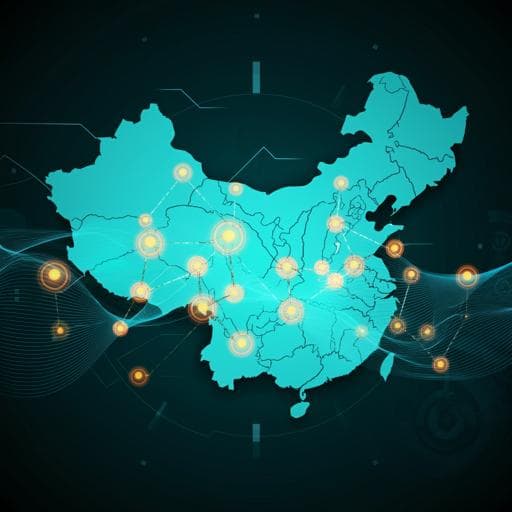
Economics
Changes in spatiotemporal pattern and network characteristics in population migration of China's cities before and after COVID-19
Y. Zhang, X. Guo, et al.
Discover how the COVID-19 pandemic reshaped population mobility in Chinese cities from 2019 to 2023. This research, conducted by Yaming Zhang, Xiaoyu Guo, Yanyuan Su, Yaya Hamadou Koura H, Na Wang, and Wenjie Song, highlights the significant impact on mid-sized migration cities and reveals the resilience of population migration amidst a public health crisis.
~3 min • Beginner • English
Introduction
The study examines how COVID-19 affected intercity population mobility in China over multiple Spring Festival periods, a time of exceptionally large and structured movements. Prior research shows mobility drives socioeconomic processes and disease transmission, but many studies relied on static data and focused on short-term pandemic impacts. Leveraging LBS/GPS-based migration big data enables dynamic, real-time insights. The authors identify a gap in understanding delayed and long-term effects of epidemics on migration, urban network robustness, and recovery. They pose two key questions: (1) What are the long-term effects of COVID-19 on large-scale population movements in China, including recovery in migration and return-to-work scales? (2) How did the population flow network and cities’ network status change before and after the epidemic? The study’s purpose is to quantify spatiotemporal changes in migration and return flows, and to assess network structural changes, thereby informing understanding of resilience, economic recovery, and appropriateness of mobility-restriction policies.
Literature Review
The paper reviews three strands of research using mobility data in relation to epidemics: (1) Correlations between mobility and cases show mobility reductions are associated with decreased transmission across many countries; mobile phone–based datasets capture spatiotemporal associations and compliance with interventions. (2) Forecasting infection trends integrates intercity travel and epidemiological models (e.g., network analysis, transfer graph neural networks), with general human movement models improving forecasts when local mobility data are absent. (3) Impacts of epidemics on mobility reveal regional heterogeneity in resilience across and within countries; COVID-19 raised mobility costs and constrained movements, with mixed findings in China on geographic distribution stability but clear changes versus SARS-era mobility. A sub-strand explores determinants of behavioral change: both voluntary responses (risk perceptions, social responsibility, fear/anxiety) and policy mandates (stay-at-home orders) shape mobility, with demographic differences in compliance. The gap identified is limited evidence on delayed and long-term impacts of COVID-19 on internal migration patterns and city-network structures, especially concerning resilience and recovery of work and production.
Methodology
Data: Baidu Migration Big Data (http://qianxi.baidu.com) provides daily in- and out-migration scale indices and origin shares for intercity inflows for 369 Chinese cities. The study window is 40 days around Lunar New Year (15 days before, 25 days after) for 5 years (2019–2023), capturing the Spring Festival travel rush.
Indicators of resilience and recovery:
- Population Migration Scale Index (PMSI): PMSI_t^i = PMSI_in^i + PMSI_out^i, measuring city i’s migration activity at time t.
- Recovery of PMSI (relative to 2019): PMSI_recovery_t^i = PMSI_t^i / PMSI_{2019}^i; values >1 indicate higher activity than 2019.
- Population Return Scale Index (PRSI): PRSI_t^i = PMSI_in^i − PMSI_out^i, representing net inflow (positive) or outflow (negative) during return-to-work.
- Recovery of PRSI (relative to 2019): PRSI_recovery_t^i = PRSI_t^i / PRSI_{2019}^i; higher values reflect better resumption of work and production.
Spatial classification and clustering: Cities’ average daily PMSI and PRSI are classified into seven groups using Natural Breaks (Jenks) in ArcGIS. Cluster and Outlier Analysis (Anselin Local Moran’s I) assesses spatial clustering of recovery.
Social network analysis (SNA): Construct a 369×369 intercity population migration matrix with link weights PM_{ij}^t = (PR_{ij}^t / Σ_j PR_{ij}^t) × PMSI_t^i × 1000, where PR_{ij}^t is the share of inflow to i from j at time t. Network metrics computed annually (40-day aggregates) include Degree, Weighted Degree, Density, Average Clustering Coefficient, and Average Path Length. Community detection uses Gephi’s Modularity (resolution 1.0) with PM as weights; modularity values >0.44 indicate meaningful community structure. The study compares 2020–2023 networks against 2019 baselines to evaluate long-term effects and recovery trajectories.
Key Findings
Temporal stages and magnitudes:
- Homecoming period: 2020 PMSI resembled 2019 early on (impact lag), but 2021 saw a sharp decline with national average daily PMSI down 47.77% vs 2019; 2022 began recovery; 2023 exceeded 2019 with average daily PMSI +12.67%.
- Holiday period: 2020 PMSI fell rather than rising, indicating near-stagnation of intercity movement under heightened risk perception and controls. In 2023 post-liberalization, PMSI peaked Jan 27 and exceeded the historical same-period PMSI by 36.19%; average daily PMSI +26.20% vs 2019.
- Return period: 2020 average daily PMSI was 78.78% lower than 2019, revealing severe disruption to resumption of work/production. In 2021, the gap narrowed notably after the Lantern Festival (−30.71% before vs −16.02% after), and by 2022–2023 migration had largely recovered.
Spatial patterns:
- Persistent low-activity areas (average daily PMSI ≤2) with little COVID-19 effect include parts of Northeast, Northwest, Qinghai–Tibet, South China (Hainan, Taiwan, Hong Kong, Macao), and Southwest (Yunnan). Megacities (e.g., Shanghai, Guangzhou, Shenzhen, Dongguan, Chengdu) maintained very high PMSI (>9) and were less affected.
- By 2023, 28.46% of cities improved their PMSI rank relative to 2019; only Hong Kong, Macao, and Jiamusi declined. Urban population movement proved resilient with minimal aftereffects.
- Spatial recovery clusters: High-High clusters early in 2020 in Qinghai–Tibet and parts of Guangdong/Hunan; by 2021–2023, high-high clustering persisted mainly in Qinghai–Tibet, indicating earlier recovery in remote, less accessible regions. Low-low clusters in Central/East China in 2020 dissipated by 2021–2023, but persistent low-low clustering was observed in Northeast China from 2021 onward.
Population return (PRSI):
- Provincial level: In 2020, strict controls led to no provinces classified as high inflow, moderate inflow, or high outflow; over half showed relative equilibrium, signaling suppressed interprovincial returns. By 2023, return scales largely recovered to 2019 levels, with shifts suggesting lateral changes in employment opportunities: net outflows decreased in Hunan, Sichuan, Shanxi; increased in Hebei, Guizhou, Yunnan.
- Urban level: In 2023, 91.87% of cities retained their 2019 PRSI-based classification; 30 shifted. Equilibrium cities rose from 164 to 173, implying freer bidirectional mobility and possibly narrowing intercity economic differences. Recovery trend in PRSI moved “west to east and south to north.” By 2023, 78.92% of cities had daily average PRSI ≥80% of 2019; 52.57% exceeded historical levels.
Network structure (2020→2023):
- Average Degree: 246.065 → 203.967 (decreasing).
- Average Weighted Degree: 2,742,986.888 → 5,875,478.138 (increasing).
- Density: 0.670 → 0.554 (decreasing).
- Average Clustering Coefficient: 0.712 → 0.597 (decreasing).
- Average Path Length: 1.326 → 1.447 (increasing).
Interpretation: 2020 exhibited more direct but lighter connections (high degree, low weight), consistent with risk-averse direct routing and fewer transfers; by 2023, the network showed more pronounced small-world properties (clustering 0.597; path length 1.447).
Community evolution:
- Modularity values indicate strong community structure: 0.628 (2020), 0.690 (2021), 0.679 (2022), 0.662 (2023).
- Stable communities across years: Northeast China, Xinjiang, Henan, Taiwan, Hainan. Major changes concentrated in southern China. In 2021, 88 cities shifted communities; Hunan and Yunnan formed separate provincial communities; parts of Zhejiang/Jiangxi moved between Jiangsu and Fujian communities. In 2022, Hunan community dissolved into South China; Fujian cohesion weakened with many cities absorbed by South China or Jiangsu communities. In 2023, an East China Community formed from closer Jiangsu–Fujian ties plus breakaways from South China; Hunan and Hubei cities formed a joint community. Overall, community boundaries align closely with provincial borders, reflecting strong intra-provincial ties. Across 2020–2023, 119 cities (32.25%) transferred communities: 69 once, 20 twice, 30 three times.
Discussion
The findings address the core questions by showing that COVID-19’s impact on intercity migration in China was predominantly short-term, with rapid recovery in both migration (PMSI) and return-to-work (PRSI) scales by 2022–2023. Network analyses reveal that while the scale of flows contracted during the pandemic, the topology exhibited increased directness of connections in 2020, consistent with behavioral adaptations (risk aversion, fewer transfers) and policy-induced constraints. Spatial heterogeneity is marked: remote regions recovered earlier, while Northeast China showed persistent slower recovery. The rise in equilibrium cities suggests reduced one-directional flows and possibly narrowing economic differentials across some cities. Community detection underscores strong geospatial and administrative effects: most communities mirror provincial borders, and southern urban agglomerations display greater volatility in community affiliation.
Comparisons with other countries show similar early pandemic reductions in internal migration and largely temporary pattern changes, but China’s strong provincial alignment of mobility communities is distinctive, likely reflecting cultural and administrative structures. Policy implications include the resilience of mobility systems, the sensitivity of interprovincial labor returns to short-term controls, and the usefulness of spatiotemporal big data for monitoring recovery and informing targeted interventions during public health crises.
Conclusion
This study builds a five-year (2019–2023) picture of Chinese intercity mobility during Spring Festival using Baidu Migration data, constructing PMSI and PRSI recovery indices and a weighted intercity network to examine spatiotemporal patterns and network evolution before and after COVID-19. Key conclusions: (1) COVID-19 mainly induced short-term shocks to migration and return flows; long-term aftereffects are minimal, with recovery by 2022–2023. (2) Impacts and recovery are regionally differentiated, with recovery in population return generally proceeding from west to east and from south to north; Northeast China exhibits sustained weaker recovery clusters post-2021. (3) Urban networks showed higher direct connectivity but lower weights in 2020, evolving to stronger small-world characteristics by 2023. (4) Community structures are robust and closely aligned with provincial borders; southern regions experienced more community reconfigurations, and new communities (e.g., East China; Hunan and Hubei) emerged in 2023. The number of equilibrium cities increased post-epidemic, indicating more balanced bidirectional flows. Future research should probe causal drivers (e.g., transport, settlement policies, economic conditions) with modeling to disentangle mechanisms behind observed changes.
Limitations
(1) Baidu Migration data are derived from LBS-based smart device users and may underrepresent populations without smart devices (e.g., some elderly or remote-area residents). (2) The 2019 baseline may not perfectly capture pre-pandemic regularity due to city-specific policies introduced that year affecting in-migration. (3) The study emphasizes describing changes rather than fully explaining causes; future work should model determinants (transport conditions, settlement policies, economic development, city-specific factors) to clarify mechanisms.
Related Publications
Explore these studies to deepen your understanding of the subject.







